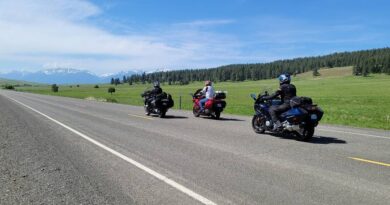
Motorcycle Group Riding Basics
Editor’s Note: This article was originally published on February 15, 2020 and has since been updated to ensure it remains accurate, relevant, and useful for readers.
What’s more fun than riding? We’d say riding with a group of friends of course. After all, at our core we’re social creatures. We intuitively know that sharing an adventure with others brings variety and new perspectives to the experience. The personal bonding is powerful too. Stories are told and retold for years to come. And like fishermen, they get bigger and grander, more dramatic and daring with every telling. Without any shame at all, new bits get added – real, exaggerated, and sometimes even imagined. But then that’s what makes storytelling with friends so much fun.
Before we get into group riding, let’s be clear about what that means to us. Our idea of a group ride happens when people connected in some way, even by a mere passion to ride, head out together for several days of like-minded fun along an agreed route. Guided tours, fund-raising rides, and club rides are not what we have in mind.
Keep it Manageable – Group Size Matters.
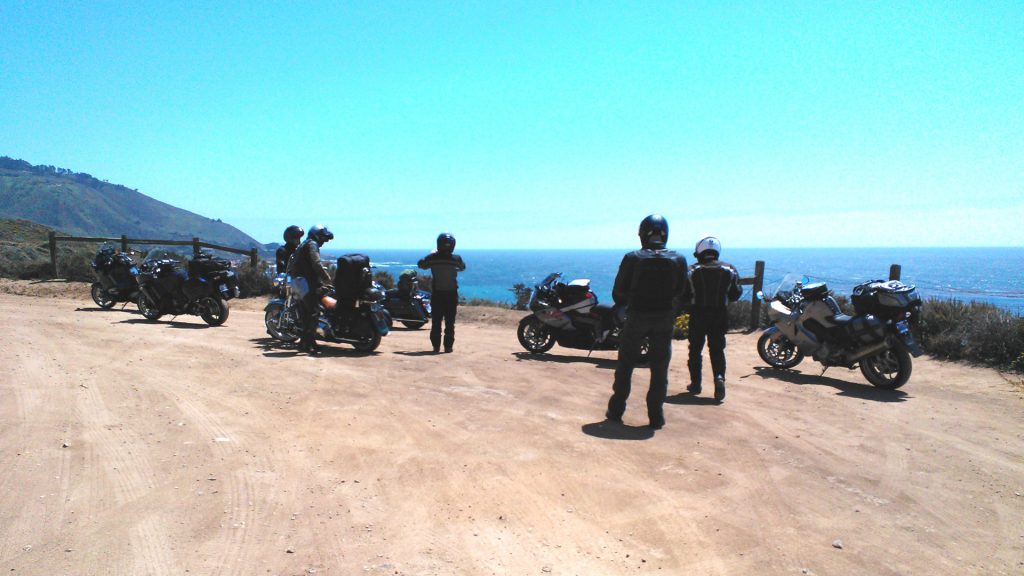
Okay then, let’s talk about group riding. To begin with, a group includes at least three riders; two riders are just too few to create a genuine group dynamic. On the other hand, there’s no upper limit although for practical reasons four to six is about right. When a group gets too big, the basics get complicated and take longer for everyone. For example, sharing gas pumps at small stations means stops take multiple times longer as the group gets bigger. Similar extra time is typical at restaurants too. In fact the number stops for any reason at all simply increase in proportion to the size of the group.
And if logistics aren’t enough, consider what happens when opinions proliferate about everything from where and when to stop, to routes, and everything in between. It gets hard. Pack extra patience – it’ll come in handy.
One more thought about forming a manageable group. If your tour plan covers a lot of miles, or you ride in a spirited way, then stick with smaller groups of like-minded riders. Everyone will be happier. Our rule of thumb is to keep the number to a manageable 4 to 6 riders.
Someone has to lead.
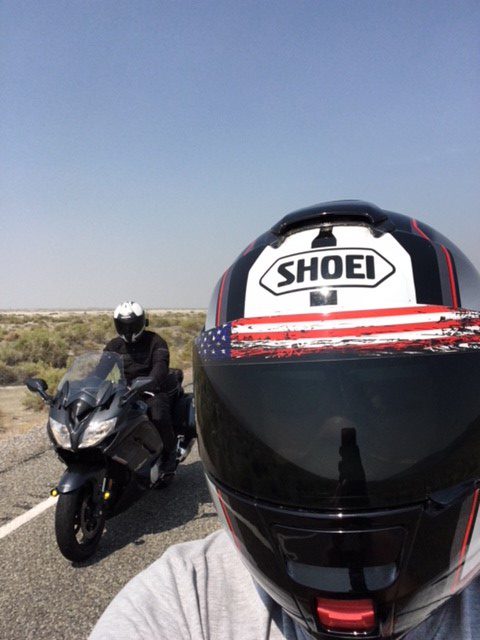
Even if the person up front only thinks he’s leading, the very fact that he’s there makes him the leader. At least for that moment. Every group needs a leader. Someone who in many ways thinks for the whole group letting everyone else pretty much relax and enjoy the ride. It’s not easy to lead. But leading has its rewards. For example an unobstructed view of what’s ahead. Leaders also make the call for gas stops and breaks. The leader may spot the perfect vistas for a photo op, or a great place to stop for lunch. These decisions are a blend of leadership prerogative and responsibility.
So what does it take to lead? And how does a group settle on a leader in the first place? Technically anyone in the group can lead, and at any given time leaders may rotate. But good leaders focus on three things.
- They know the route and can read a map. No one likes to take wrong turns, or waste time backtracking. A good leader keeps those frustrations to a minimum.
- Rides well, really well. Probably better than most in the group.
- Genuinely accommodates the needs and interests of others. It’s not always easy to be patient, but leaders try to make choices for the group that work best for everyone; like setting a good pace, stopping every so often, and making sure no one gets lost or falls too far behind.
Someone has to follow.
As the saying goes, if you’re not leading you’re following. And that demands more awareness than going solo. Group riding creates its own challenges beyond the usual cars and road hazards. Riders also have to watch out for each other. Groups usually ride in close formation, safely spaced in a zig-zag pattern. Even so, they need to watch for unexpected slowdowns or evasive maneuvers.
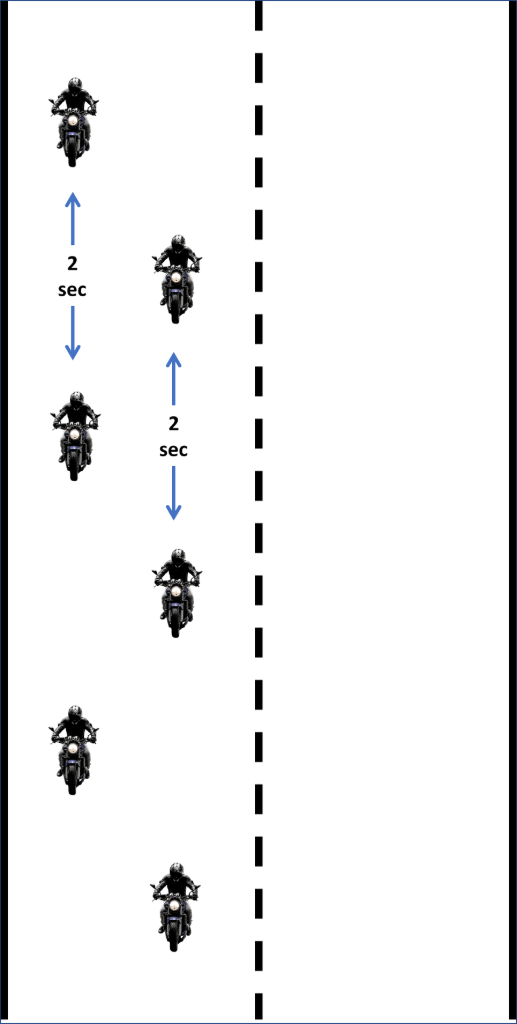
When riding in a group, keep these tips in mind:
- Be on the opposite side of the lane in which the motorcycle just ahead of you is traveling at about one car length distance (you should be two car lengths behind the bike on the same side of the lane and directly in front of you).
- Keep an eye on that rider and the rider directly in front of you watching for any change in direction or speed.
- Still look as far ahead as practical, beyond all riders, to get early indications of upcoming curves and potential hazards.
- Avoid sudden changes in your own direction and speed, be mindful of the riders behind you.
- Be a spotter for the riders behind you – if you see a road hazard indicate that with a foot gesture.
- In tighter turns, particularly at speed, break out of the zig-zag formation and line-up to take an optimal line while leaving a little extra space between riders. Re-group after the turn.
If riders get separated don’t panic; everyone should know the route and the next meetup point. Relax and focus on safely getting there. Take your time and stay in your comfort zone. We know a few people who were pulled over trying to catch-up. They all said the same thing – it wasn’t worth it.
It’s important to also mention that everyone in the group holds some leadership responsibility. Riders need to know the route, the meet-up points, and of course how to ride with others. In the likely (yes likely) event the group gets separated, everyone should expect to regroup at the next meetup point. It’s a group ride after all.
A word about passing.
Passing is an important part of group riding that calls for decisive leadership. Knowing when to pass (and when to let others pass) can be tricky. Done well, the group overtakes smoothly one at a time. Done poorly, passing takes on unnecessary risk, riders get separated, and the group no longer looks like a group.
It’s not uncommon to find yourself staring at the back of one or two RVs and itching to get past. The leader has to make the call taking into account time and distance to ensure the rest of the group can safely follow. There are some roads where every rider is on his or her own. The long twisty sections of Pacific Coast Highway are a good example. On any summer day it seems like every RV in California is out there doing 25 miles an hour. Passing as a group is just not practical, so each rider has to wait for their turn and the right opportunity. Eventually the road straightens out a bit and any stragglers catch-up.
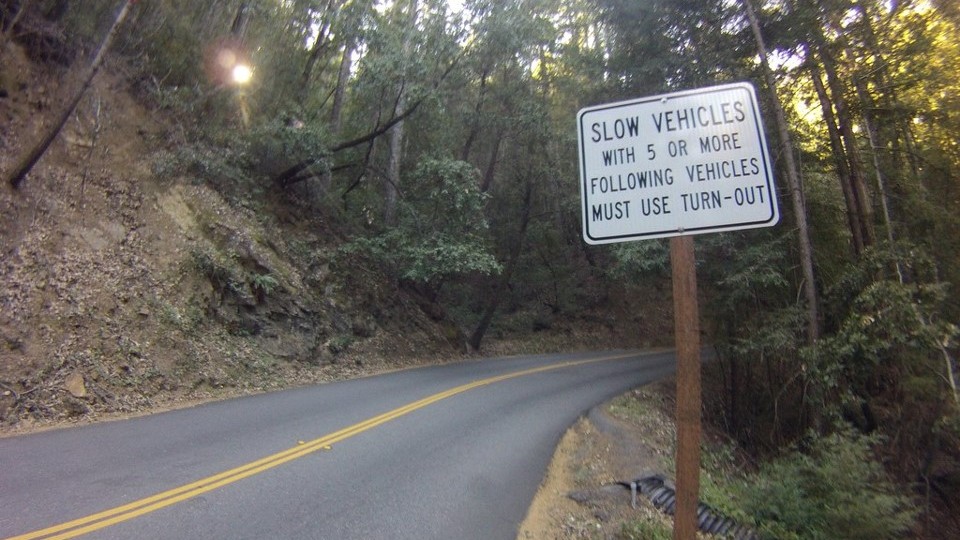
Actually passing is done one at a time, in order from front to back, with each rider assessing and deciding when to execute the pass. If the passing opportunity closes, perhaps the passing lane ends or oncoming traffic prevents a safe pass, then everyone waits for the next opportunity. And typically, the riders who were able to pass ride a little slower to allow the group to catch-up.
It’s up to the leader to be situationally aware in all directions including behind the group. In some cases, the group may have to yield to approaching traffic. Riders in the back can signal the leader when approaching traffic wants to pass. There’s no fun in being followed by an increasingly impatient angry driver.
Group riding is a learning opportunity.
Group riding can be a great opportunity to learn new riding techniques from more experienced riders. Start by following a good rider. Watch the way he or she uses the brakes in a corner, their entry and exit speeds, their line through the turn, and just as importantly where they are looking. It’s hard to take all of that in every time, but over a long ride there are many opportunities to observe. One major caution here. Following a good rider can lead you to lose track of your own speed and get outside your comfort zone. Don’t get lured into riding beyond your capability. It’s okay to fall back.
Gear-up for a group ride.
Before heading out on a group ride, you may want to consider bringing along a few important accessories. Here’s our list of the two most useful.
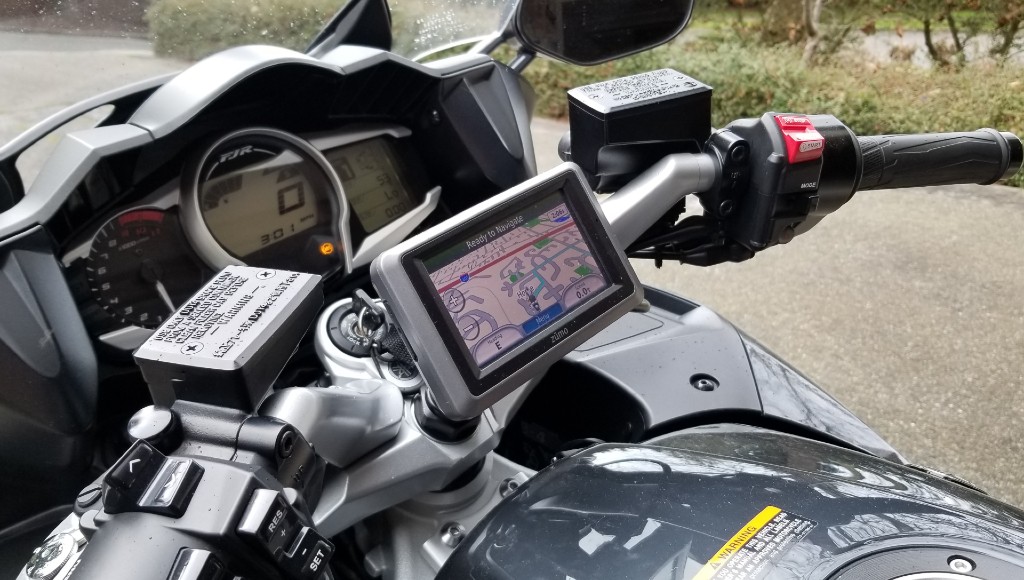
A GPS Unit – Most American Sport Touring riders probably already installed a fixed-mount GPS. But if not you should. The extra confidence and peace of mind that come from having a cheery voice calling out every turn makes this the single best investment for group rides or any ride really. Read our reviews of the Garmin Zumo 595LM and Zumo XT to learn more about motorcycle GPS systems.

Rider-to-rider communication system – Without a doubt group riding is social. The ability to chat, make everyone aware of upcoming stops, or give a heads up on hazards are just a few reasons we love comms. There are a lot of systems on the market, but for price, performance, and features we really like the Cardo PackTalk. You can also check customer reviews, pricing and availability on Amazon.com.
Memories with Friends
Motorcycling is both a singular activity and at the same time can be a group activity. Riding with friends adds perspective to any road. Every rider makes different decisions. Watch the bike in front. When do the brakes come on before a corner? What line did the rider chose? How was their exit? The number of other more subtle ways each rider shows a personal style seem endless. Group rides mix learning, socializing, and of course riding in a blend sure to make lasting memories. Plan a ride with friends.
[placeholder text]
Your response is used by American Sport Touring only, we do not store or sell your information.
Please read our Privacy Policy.

by John DeVitis, Editor and Publisher
John DeVitis, Editor & Publisher of American Sport Touring, has spent years riding and writing with a focus on long-distance, performance-oriented motorcycling. His time on the road has revealed little-known routes across the United States and Canada, along with practical insights into the bikes, gear, and techniques that matter to sport touring riders. He draws on this experience, together with a background in digital publishing, to guide the editorial principles and clear vision behind American Sport Touring, delivering content riders can trust.


